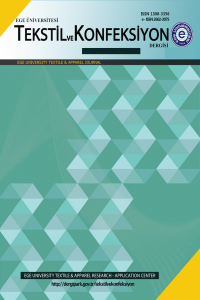GİYSİ ÜRETİM BANTLARINDAKİ DÜZENSİZLİKLERİN ANALİZİ
Düzensizlik, Bekleme zamanı, Düzensizlik yönetimi, Etkili yönetim
ANALYZING THE DISTURBANCES IN GARMENT MAKING LINES
Disturbance, Waiting Time, Disturbance Management, Effective Manufacturing,
___
- 1. Stahre, J., “Disturbance Handling in Continuous Development of Manufacturing Systems”, Proper Project Proposal-Area of Manufacturing Systems, (1999) Available from: http://www.ege.edu.tr/
- 2. Ingemansson, A., and Bolmsjö, G.S., “Improved Efficiency with Production Disturbance Reduction in Manufacturing Systems Based on Discrete-Event Simulation”, Journal of Manufacturing Technology Management, Volume 15, No 3, (2004) pp.267-279.
- 3. Bellgran, M., and Aresu, E., “Handling Disturbance in Small Volume Production” Robotics and Computer Integrated Manufacturing, Volume 19, (2003) pp.123-134.
- 4. Kuivanen, R., “Disturbance Control in Flexible Manufacturing” International Journal of Human Factors in Manufacturing”, Volume 6, (1996) pp.41-46.
- 5. Schumacher, J., “A Disturbance Management Approach to Improving the Performance of Batch Process Operations”, Ph D Thesis, Delft University of Technology, Faculty of Technology, (1999) .
- 6. Mattson, J. and McFarlane, D., “Assessing the Responsiveness of Existing Production Operations”, International Journal of Operation & Production Management, Volume 19, No 8, (1999) pp 69-76.
- 7. Barroso, M.P. and Wilson, J.R., “Human Error and Disturbance Occurrence in Manufacturing Systems: Toward the Development of an Analytical Framework” Human Factors and Ergonomics in Manufacturing, Volume 9, No 1, September, (1999), pp.87-104.
- 8. Frizelle, G., et al,“Disturbance “Measurement in Manufacturing Production Systems”, In Proceedings of ASI, Bremen, Germany (1998).
- 9. Fjallström, S. and Bellgran, M., “Communication and Co-Operation for Flexible and Robust Production Systems”, Sixteenth Annual Conference of POM, Chicago, IL, April 29-May 2, (2005).
- 10. Chong, C.S., Appa, I.S. and Gay, R., “Simulation-Based Scheduling for Dynamic Discrete Manufacturing Systems” Proceedings of the Winter Simulation Conference, (2003), pp.1465-1473.
- 11. Yin, R.K., Case Study Research, Thousand Oaks, Sage Publications, Inc (1994).
- ISSN: 1300-3356
- Yayın Aralığı: Yılda 4 Sayı
- Başlangıç: 1991
- Yayıncı: Ege Üniversitesi
DOĞAL ELYAF KARIŞIMLI POLİÜRETAN KOMPOZİTLERİN SES VE ISI YALITIM ÖZELLİKLERİNİN İNCELENMESİ
B. Yeşim BÜYÜKAKINCI, Nihal SÖKMEN, Haluk KÜÇÜK
TÜRK KONFEKSİYON ENDÜSTRİSİ İÇ ANALİZİ VE KÜRESELLEŞME STRATEJİLERİNİN DEĞERLENDİRİLMESİ
Selin Hanife ERYÜRÜK, Fatma KALAOĞLU, Murat BAKSAK
KUMAŞ POROZİTESİNİN BELİRLENMESİNDE GÖRÜNTÜ MODELLEMESİNİN KULLANIMI: FILAMENT İPLİKLİ DOKUMA KUMAŞ
ATMOSFERİK KOŞULLARDAKİ DEĞİŞİMİN BAZI DERİ FİZİKSEL ÖZELLİKLERİNE ETKİSİ
Bahri BAŞARAN, Behzat Oral BİTLİSLİ, Buğra OCAK, Ersin ÖNEM
YUVARLAK ÖRME MAKİNELERİ İÇİN ON-LİNE HATA KONTROL SİSTEMİ
Tuba KIRCI TORUN, Arzu MARMARALI
HAZIR GİYİM SEKTÖRÜNDE İŞÇİ SEÇİMİ VE EĞİTİMİ ÜZERİNE BİR ARAŞTIRMA
Gülseren KURUMER, Gülseren KARABAY, Sibel SEVER
ŞENİL VE MAKARNA İPLİKLERDEN ÜRETİLEN DÜZ ÖRGÜ KUMAŞLARIN BOYUTSAL ÖZELLİKLERİ
